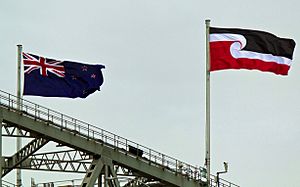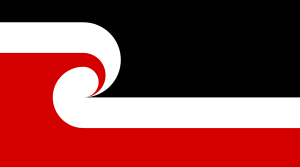Tino rangatiratanga facts for kids

Tino rangatiratanga is a Māori language term. It means "absolute sovereignty." Sovereignty means having complete power to rule something. It also means no one else can interfere. For the Māori people, this term means they can rule themselves. It also means they are recognized as the owners of their land. The term "tino rangatiratanga" is in the Māori version of the Treaty of Waitangi. The Māori signed this treaty with the British in 1840. The treaty promised that Māori would keep tino rangatiratanga forever. But the British colonizers did not respect this idea. They took many things from the Māori people. Even today, people in New Zealand disagree. They don't agree on what "tino rangatiratanga" truly means. They also disagree on what it should cover.
Contents
What Does Tino Rangatiratanga Mean?
In Māori culture, a rangatira is a chief. The ending "-tanga" is added to words. It refers to the qualities of being something. So, rangatiratanga means the qualities of a chief. The word "tino" in Māori means "most" or "absolute." When these words are put together, "tino rangatiratanga" means that Māori chiefs have complete control. It means they can fully use their powers as leaders.
Some people think this term describes self-determination. This means people can choose their own future. It can also mean autonomy, which is self-governance. Or it can mean Māori independence.
The Treaty of Waitangi and Tino Rangatiratanga
There is a lot of confusion about the Treaty of Waitangi. This is because Article 1 and Article 2 say different things. This is true in both the English and Māori versions.
| English Version | Māori Version | |
|---|---|---|
| Article 1 | The Māori people give away their sovereignty to the British Crown. They do this by signing the treaty. | The Māori people give away their "kawanatanga" (governorship). They do this by signing the treaty. The Māori did not have kings or queens. So, this word was used to describe the idea of ruling. The Māori word "kawana" comes from the English word "governor." Christian missionaries created this word. They used it to describe Pontius Pilate's rule. It was also used before 1840 for the Governor of New South Wales. |
| Article 2 | The Māori are promised that their right to own their land and property will be respected. | The Māori are promised that their tino rangatiratanga will be respected. This applies to their lands, kainga (homes), and other taonga (treasures). |
In the Māori version of the treaty, Article 1 talks about kawanatanga (governorship). But Article 2 talks about tino rangatiratanga (absolute chieftainship). To Māori people, these are two very different ideas. Because of this, they believe they never gave away their land rights. They also believe they never gave away their ability to rule themselves. In fact, a special group called a tribunal was created. This group focuses on the Treaty of Waitangi. They said that the Māori can never give up those rights. They also said the Māori never did.
The Tino Rangatiratanga Flag
There is a special flag called the Tino rangatiratanga flag. It is used to represent the Māori people. This flag has three colors: red, white, and black. Three Māori artists designed it in 1990. Their names were Hiraina Marsden, Jan Smith, and Linda Munn. They designed it as part of a contest.
A woman named Poua Erstich explained the meaning of the flag. The red color stands for the sky. The black color stands for the earth. The white color is the light. It separates the sky and the earth. The flag is meant to show the Māori story of how the world was created.
This flag is often flown next to the flag of New Zealand. This shows people that the land still belongs to the Māori. Sometimes, this flag is used during protests. It helps show how certain issues are affecting Māori people.
See also
 In Spanish: Tino rangatiratanga para niños
In Spanish: Tino rangatiratanga para niños


